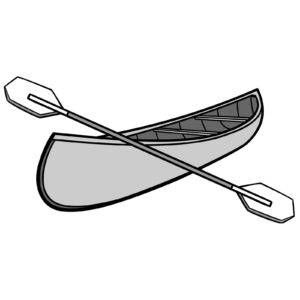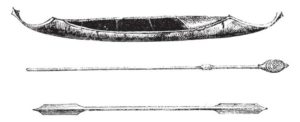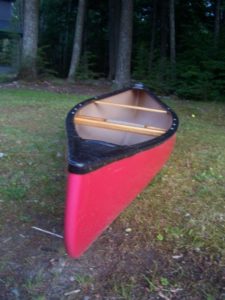This lesson explores how engineering has impacted the manufacturing of canoes over time, including the development of new, durable, and lighter materials. Students work in teams to design and build their own canoe.
- Learn about materials engineering.
- Learn about engineering design.
- Learn about planning and construction.
- Learn about teamwork and working in groups
Age Levels: 8-18
Materials & Preparation
Build Materials (For each team)
Required Materials
- Popsicle sticks
- Wood spoons
- Small wood (balsa) pieces
- Bendable wire (such as florist, craft wire or pipe cleaners)
- String
- Paperclips
- Rubber bands
- Toothpicks
- Aluminum foil
- Plastic wrap
- Wood dowels
- Glue
Testing Materials
- Water
- Large basin or sink
- Measuring cup or pouring device
Testing Materials & Process
Materials
- Water
- Large basin or sink
- Measuring cup or pouring device

Larry-Rains-bigstock.com
Process
Pre-fill a water basin or sink with enough water to allow the canoe’s to float. Test each team’s canoe design by setting a timer for 3 minutes and placing it in the basin/sink. Teams observe what happens to the design and document the condition of their canoe following the 3-minute float test.
Engineering Design Challenge
Design Challenge
You are part of a team of engineers who have been given the challenge to design your own canoe out of everyday materials. Your canoe will need to float for three minutes, without falling apart, sinking or capsizing. It must also be a minimum of 8 inches in length.
Criteria
- Must float for 3-minutes.
- Must be at least 8 inches in length.
Constraints
- Use only the materials provided.
- Teams may trade unlimited materials.
Activity Instructions & Procedures
- Break class into teams of 2-3.
- Hand out the Can You Canoe? worksheet, as well as some sheets of paper for sketching designs.
- Discuss the topics in the Background Concepts Section. Consider asking students whether they have ever been on a canoe. Have a discussion about what you need to do on a canoe so that it doesn’t tip over and how to make it move forward.
- Review the Engineering Design Process, Design Challenge, Criteria, Constraints and Materials.
- Provide each team with their materials.
- Explain that students must design and build a canoe out of everyday materials. The canoe will need to be able to float for three minutes, without falling apart, sinking or capsizing. Remember, to keep in mind that many of the parts will be exposed to water.
- Announce the amount of time they have to design and build (1 hour recommended).
- Use a timer or an on-line stopwatch (count down feature) to ensure you keep on time. (www.online-stopwatch.com/full-screen-stopwatch). Give students regular “time checks” so they stay on task. If they are struggling, ask questions that will lead them to a solution quicker.
- Students meet and develop a plan for their canoe. They agree on materials they will need, write/draw their plan, and present their plan to the class. Teams may trade unlimited materials with other teams to develop their ideal parts list.
- Teams build their designs.
- Pre-fill a water basin or sink with enough water to allow the canoe’s to float. Test each team’s canoe design by setting a timer for 3 minutes and placing it in the basin/sink.
- Teams observe what happens to the design and document the condition of their canoe following the 3-minute float test.
- As a class, discuss the student reflection questions.
- For more content on the topic, see the “Digging Deeper” section.
Extension Idea
For older students, require teams to develop a canoe that can float while holding a load, such as a stack of coins.
Student Reflection (engineering notebook)
- Did you succeed in creating a canoe that floated for three minutes? If not, why did it fail?
- Did you decide to revise your original design or request additional materials while in the construction phase? Why?
- Did you negotiate any material trades with other teams? How did that process work for you?
- If you could have had access to materials that were different than those provided, what would your team have requested? Why?
- Do you think that engineers have to adapt their original plans during the construction of systems or products? Why might they?
- If you had to do it all over again, how would your planned design change? Why?
- What designs or methods did you see other teams try that you thought worked well?
- Do you think you would have been able to complete this project easier if you were working alone? Explain…
- If you were designing a new, full scale, canoe — what features would you like to design in? Would this require new materials?
Time Modification
The lesson can be done in as little as 1 class period for older students. However, to help students from feeling rushed and to ensure student success (especially for younger students), split the lesson into two periods giving students more time to brainstorm, test ideas and finalize their design. Conduct the testing and debrief in the next class period.
Engineering Design Process
Background Concepts
Canoe Structure and Materials

PixelsAway-bigstock.com
Parts of a Canoe
- Bow
- Stern
- Hull
- Seat
- Thwart – a horizontal crossbeam near the top of the hull
- Gunwale – the top edge of the hull
- Deck
The First Canoe Materials

Morphart-bigstock.com
The earliest canoes were made from available, natural, and usually local materials. The earliest canoes were made of wood, sometimes hollowed-out tree trunks. Wooden canoes are more frequently made in a “wood strip” process, where strips of wood are bent and attached to form a frame. The frame would originally be covered by birch bark, or other natural materials. Many indigenous peoples of the Americas built canoes of tree bark, sewn with tree roots and sealed with resin. The indigenous people of the Amazon commonly used Hymenaea trees. In temperate North America, white cedar was used for the frame and bark of the Paper Birch for the exterior, with charcoal and fats mixed into the resin to help waterproof it. This type of canoe is still made by hand today, and for some is the preferred canoe. There are some who still cover with bark, and others who use canvas instead. However, the amount of time and the craftsmanship required to build a wooden canoe can make the end product very expensive. They can be considered works of art!
New Materials
Over the years, many companies have developed or incorporated new materials to help improve durability, decrease weight, and change the performance of canoes. Aluminum canoes were first made by the Grumman Company in 1944, when demand for airplanes for World War II began to drop off. Aluminum canoes were much lighter and potentially durable than wood canoes. But, aluminum had drawbacks too! Capsized aluminum canoes will sink unless the ends are filled with flotation materials. And, aluminum canoes can be very noisy, and would scare away wildlife and even make it difficult to talk with others nearby.
Canoe Structure and Materials

VanVoorhis
Engineered Materials
About fifty years ago, new materials such as fiberglass, Kevlar, and carbon fibers began to be used in canoe construction. The new engineered materials were much lighter than wood, very strong, and resulted in a canoe that was easier to maneuver. In addition, different widths and depths were achievable, allowing for canoes customized for various functions. For example, wider, lightweight canoe could be selected by recreational canoers with little experience — the wider canoe would be more stable and less likely to capsize. More streamlined versions for racing or stronger more experienced canoers were also developed. The new materials were also more resistant to the weather, and could handle harsh winters left out of doors. There were drawbacks to the new materials as well. For example, fiberglass can crack upon an impact. But…fiberglass can be repaired too! Often repair kits are brought along on trips in rough terrain.
Many materials and new methods have been used to improve canoe performance, reduce costs, and boost safety. But, some companies still offer both the hand crafted wood and canvas canoes alongside the new materials. For example, Old Town Canoes (Old Town, Maine, USA) has been in business for more than a century, but recently introduced a new innovation in composite canoes. According to the company, the new “Koru”™ blends the performance features of Native American hunting canoes with aerospace composite technology and modern design features. The “Koru” can be bumped, and then will bump back into its original shape. It can also be crafted with very sharp entry and exit points that make the canoe quicker in the water than other shapes. The engineered materials allowed for a canoe that is 17.5 feet long, and yet weighs only 50 pounds.
Engineered Shapes!
And…engineering isn’t limited to new materials! For example, while many people like to bring their pets on boats, having one ride on a kayak was a little challenging. But recently designers at Old Town Canoe introduced what they call the “Sidekick” — a companion platform for non-paddling passengers – with two legs or four.
Vocabulary
- Bow: The forward part of the hull of a ship or boat.
- Canoe: A narrow, keelless boat with pointed ends, propelled by a paddle or paddles.
- Constraints: Limitations with material, time, size of team, etc.
- Criteria: Conditions that the design must satisfy like its overall size, etc.
- Engineers: Inventors and problem-solvers of the world. Twenty-five major specialties are recognized in engineering (see infographic).
- Engineering Design Process: Process engineers use to solve problems.
- Engineering Habits of Mind (EHM): Six unique ways that engineers think.
- Gunwale: The top edge of the hull.
- Hull: The watertight body of a ship, boat, or flying boat.
- Iteration: Test & redesign is one iteration. Repeat (multiple iterations).
- Prototype: A working model of the solution to be tested.
- Stern: The rear of a ship or boat.
- Thwart: A horizontal crossbeam near the top of the hull.
Dig Deeper
Internet Connections
Recommended Reading
- Building a Strip Canoe (ISBN: 978-1565234833)
- This Old Canoe: How To Restore Your Wood-Canvas Canoe (ISBN: 978- 0994863300)
Writing Activity
Write an essay or a paragraph about how engineering has changed cargo ships over the past 100 years.
Curriculum Alignment
Alignment to Curriculum Frameworks
Note: All lesson plans in this series are aligned to the National Science Education Standards which were produced by the National Research Council and endorsed by the National Science Teachers Association, and if applicable, also to the International Technology Education Association’s Standards for Technological Literacy or the National Council of Teachers of Mathematics’ Principles and Standards for School Mathematics.
National Science Education Standards Grades K-4 (ages 4 – 9)
CONTENT STANDARD A: Science as Inquiry
As a result of activities, all students should develop
- Abilities necessary to do scientific inquiry
- Understanding about scientific inquiry
CONTENT STANDARD E: Science and Technology
As a result of activities, all students should develop
- Abilities of technological design
CONTENT STANDARD F: Science in Personal and Social Perspectives
As a result of activities, all students should develop understanding of
- Science and technology in local challenges
CONTENT STANDARD G: History and Nature of Science
As a result of activities, all students should develop understanding of
- Science as a human endeavor
National Science Education Standards Grades 5-8 (ages 10 – 14)
CONTENT STANDARD A: Science as Inquiry
As a result of activities, all students should develop
- Abilities necessary to do scientific inquiry
- Understandings about scientific inquiry
CONTENT STANDARD E: Science and Technology
As a result of activities in grades 5-8, all students should develop
- Abilities of technological design
- Understandings about science and technology
CONTENT STANDARD F: Science in Personal and Social Perspectives
As a result of activities, all students should develop understanding of
- Risks and benefits
- Science and technology in society
CONTENT STANDARD G: History and Nature of Science
As a result of activities, all students should develop understanding of
- Science as a human endeavor
- History of science
National Science Education Standards Grades 9-12 (ages 14-18)
CONTENT STANDARD A: Science as Inquiry
As a result of activities, all students should develop
- Abilities necessary to do scientific inquiry
- Understandings about scientific inquiry
CONTENT STANDARD E: Science and Technology
As a result of activities, all students should develop
- Abilities of technological design
- Understandings about science and technology
CONTENT STANDARD F: Science in Personal and Social Perspectives
As a result of activities, all students should develop understanding of
- Personal and community health
- Science and technology in local, national, and global challenges
CONTENT STANDARD G: History and Nature of Science
As a result of activities, all students should develop understanding of
- Nature of scientific knowledge
- Historical perspectives
Standards for Technological Literacy – All Ages
The Nature of Technology
- Standard 1: Students will develop an understanding of the characteristics and scope of technology.
Technology and Society
- Standard 4: Students will develop an understanding of the cultural, social, economic, and political effects of technology.
- Standard 6: Students will develop an understanding of the role of society in the development and use of technology.
- Standard 7: Students will develop an understanding of the influence of technology on history.
Design
- Standard 8: Students will develop an understanding of the attributes of design.
- Standard 9: Students will develop an understanding of engineering design.
- Standard 10: Students will develop an understanding of the role of troubleshooting, research and development, invention and innovation, and experimentation in problem solving.
Abilities for a Technological World
- Standard 13: Students will develop abilities to assess the impact of products and systems.
The Designed World
- Standard 17: Students will develop an understanding of and be able to select and use information and communication technologies.
Related Engineering Fields and Degrees
Student Worksheet

PiLens-bigstock.com
You are part of a team of engineers who have been given the challenge to design your own canoe out of everyday items. Your canoe will need to be able to withstand a three minute water test, without sinking or capsizing. You’ve been given a selection of materials from which to build your canoe. You may exchange materials with other teams if you like.
Planning Stage
Meet as a team and discuss the problem you need to solve. Then develop and agree on a design for your canoe. You’ll need to determine what materials you want to use — and the steps you will take in the manufacturing process. Keep in mind that many of your parts will be exposed to water. Draw your design in the box below, and be sure to indicate the description and number of parts you plan to use. Present your design to the class. You may choose to revise your teams’ plan after you receive feedback from class.
Materials Needed: Construction Phase
Build your canoe. During construction you may decide you need additional materials or that your design needs to change. This is ok — just make a new sketch and revise your materials list.
Testing Phase
Each team will test their canoe in a classroom basin. Be sure to watch the tests of the other teams and observe how their different designs worked.
Evaluation Phase
Evaluate your teams’ results, complete the evaluation worksheet, and present your findings to the class.
Use this worksheet to evaluate your team’s results:
- Did you succeed in creating a canoe that floated for three minutes? If not, why did it fail?
- Did you decide to revise your original design or request additional materials while in the construction phase? Why?
- Did you negotiate any material trades with other teams? How did that process work for you?
- If you could have had access to materials that were different than those provided, what would your team have requested? Why?
- Do you think that engineers have to adapt their original plans during the construction of systems or products? Why might they?
- If you had to do it all over again, how would your planned design change? Why?
- What designs or methods did you see other teams try that you thought worked well?
- Do you think you would have been able to complete this project easier if you were working alone? Explain…
- If you were designing a new, full scale, canoe — what features would you like to design in? Would this require new materials?
Translations





 Industrial Engineering
Industrial Engineering
 Computer Engineering
Computer Engineering